An Influence of Thermally-Induced Micro-Cracking under Cooling Treatments: Mechanical Characteristics of Australian Granite
Abstract
:1. Introduction
2. Methodology
2.1. Rock Specimen Preparation and Heat Treatment Process
2.2. Identification of Alteration of Mechanical Properties of Harcourt Granite upon Thermal Treatment
Uniaxial Compressive Strength (UCS) Testing
2.3. Identification of Crack Initiation and Crack Damage Thresholds during Loading
Acoustic Emission (AE) Technique
2.4. Identification of the Influence of Loading and Unloading after Crack Initiation and Crack Damage on Mechanical Alteration of Harcourt Granite
Loading and Unloading Testing under Uniaxial Compression
2.5. Identification of Extent of Micro-Cracking during Thermal Treatments
Scanning Electron Microscopy (SEM) Analysis
3. Results and Discussion
3.1. Identification of Thermally-Induced Micro-Cracking in Granite during Heating and Cooling
3.2. Effect of Heating Followed by Cooling on Mechanical Properties of Granite
3.2.1. Stress-Strain Behaviour
3.2.2. Uniaxial Compressive Strength (UCS)
3.2.3. Elasticity Properties of Harcourt Granite
3.2.4. Poisson’s Ratio
3.2.5. Crack Initiation and Crack Damage Thresholds
3.3. Effect of Loading and Unloading on Mechanical Properties of Harcourt Granite
4. Conclusions
- The stress-strain response under uniaxial loading reveals that Harcourt granite deviates from brittle behaviour to a quasi-brittle behaviour with the increase of pre-heating temperature over 400 °C, and this seems significant under rapid cooling treatment due to the larger thermal shocks induced by high cooling rates. An increase in elastic properties (uniaxial compressive strength and Young’s modulus) resulted with pre-heating up to a threshold temperature (for Harcourt granite, the threshold temperature lies at around 100 °C) for both cooling treatments, due to the closure of existing fractures through thermal expansion processes. Beyond that threshold temperature, a significant decline in strength properties occured due to the rock matrix damage created by thermally-induced micro-cracking. Furthermore, the strength reduction was greater under rapid cooling, revealing that the cooling effect is crucial for the elastic properties of Harcourt granite, especially over 300 °C. Interestingly, the results revealed that the increasing temperature causes the brittle-quasi brittle transition at 600 °C.
- AE results showed that the crack initiation occurs at around 20% of the peak compressive strength of the specimens, irrespective of the pre-heating temperatures and cooling treatments, and the crack damage thresholds seem to vary with the pre-heating temperature. Early crack damage occurred with the increase of pre-heating temperature and was increased for specimens subjected to rapid cooling. Loading and unloading before failure were found to be significant for the deterioration of mechanical properties of Harcourt granite, and for pre-heating temperatures up to 400 °C, a reduction in strength properties was found in specimens subjected to loading and unloading cycles. This is probably due to rock matrix damage through the coalescence of micro-cracks. However, over 400 °C this effect seems to reduce.
- According to this study, greater thermal shocks created during rapid cooling in hot dry rocks near the injection point of geothermal reservoirs and nuclear waste disposal sites seem to cause significant matrix damage to the reservoir rock through thermally-induced micro-cracking and this effect increases with the increase of temperature. In addition, micro-cracking in adjacent regions close to the injection point which undergo slow cooling is not as critical as that in rapidly cooled areas. However, the effect of slow cooling areas also needs to be considered when planning and designing deep reservoirs for geothermal energy and nuclear waste-disposal sites. Therefore, the results of this study are important for accurately modelling the behaviour of underground geological formations; geothermal reservoirs and nuclear waste disposal sites.
Author Contributions
Conflicts of Interest
References
- International Energy Agency (IEA). World Energy Balances: Overview (2017 Edition); International Energy Agency (IEA): Paris, France, 2017; Available online: https://www.iea.org/publications/freepublications/publication/world-energy-balances---2017-edition---overview.html (accessed on 1 December 2017).
- Teke, O.; Yaşar, E. Geothermal energy and integrated resource management in Turkey. Geomech. Geophys. Geo-Energy Geo-Resour. 2018, 4, 1–10. [Google Scholar] [CrossRef]
- Budd, A.R.; Gerner, E.J. Externalities are the dominant cause of faltering in Australian geothermal energy development. In Proceedings of the World Geothermal Congress, Melbourne, Australia, 19–25 April 2015; pp. 1–13. [Google Scholar]
- Breede, K.; Dzebisashvili, K.; Falcone, G. Overcoming challenges in the classification of deep geothermal potential. Geotherm. Energy Sci. 2015, 3, 19–39. [Google Scholar] [CrossRef]
- Breede, K.; Dzebisashvili, K.; Liu, X.; Falcone, G. A systematic review of enhanced (or engineered) geothermal systems: Past, present and future. Geotherm. Energy 2013, 1, 1–27. [Google Scholar] [CrossRef]
- Budd, A. What’s Happened to Geothermal? Simple in Concept- Complex in Application; Geoscience Australia: Symonston, Australia, 2013; pp. 1–30. [Google Scholar]
- Feng, Z.; Zhao, Y.; Zhou, A.; Zhang, N. Development program of hot dry rock geothermal resource in the Yangbajing Basin of China. Renew. Energy 2012, 39, 490–495. [Google Scholar] [CrossRef]
- Zhao, Y.; Feng, Z.; Feng, Z.; Yang, D.; Liang, W. THM (Thermo-hydro-mechanical) coupled mathematical model of fractured media and numerical simulation of a 3D enhanced geothermal system at 573 K and buried depth 6000–7000 M. Energy 2015, 82, 193–205. [Google Scholar] [CrossRef]
- Brook, B.W.; Alonso, A.; Meneley, D.A.; Misak, J.; Blees, T.; van Erp, J.B. Why nuclear energy is sustainable and has to be part of the energy mix. Sustain. Mater. Technol. 2014, 1, 8–16. [Google Scholar] [CrossRef]
- Fairhurst, C. Nuclear waste disposal and rock mechanics: Contributions of the Underground Research Laboratory (URL), Pinawa, Manitoba, Canada. Int. J. Rock Mech. Min. Sci. 2004, 41, 1221–1227. [Google Scholar] [CrossRef]
- Gens, A.; Guimaraes, L.D.N.; Garcia-Molina, A.; Alonso, E.E. Factors controlling rock–clay buffer interaction in a radioactive waste repository. Eng. Geol. 2002, 64, 297–308. [Google Scholar] [CrossRef]
- Heuze, F.E. Geotechnical Modeling of High-Level Nuclear Waste Disposal by Rock Melting; Lawrence Livermore National Lab.: Livermore, CA, USA, 1981. [Google Scholar]
- Logan, S.E. Deep self-burial of radioactive wastes by rock-melting capsules. Nucl. Technol. 1974, 21, 111–124. [Google Scholar] [CrossRef]
- David, C.; Menéndez, B.; Darot, M. Influence of stress-induced and thermal cracking on physical properties and microstructure of La Peyratte granite. Int. J. Rock Mech. Min. Sci. 1999, 36, 433–448. [Google Scholar] [CrossRef]
- Vázquez, P.; Shushakova, V.; Gómez-Heras, M. Influence of mineralogy on granite decay induced by temperature increase: Experimental observations and stress simulation. Eng. Geol. 2015, 189, 58–67. [Google Scholar] [CrossRef]
- Gomez-Heras, M.; Gomez-Villalba, L.S.; Fort, R. Cambios de Fase en Litoarenitas Calcáreas con la Temperatura: Implicaciones para el Deterioro Causado por Incendios. Macla Rev. Soc. Esp. Mineral. 2010, 13, 101–102. [Google Scholar]
- Spearing, D.R.; Farnan, I.; Stebbins, J.F. Dynamics of the α-β phase transitions in quartz and cristobalite as observed by in-situ high temperature 29 Si and 17 O NMR. Phys. Chem. Miner. 1992, 19, 307–321. [Google Scholar] [CrossRef]
- Géraud, Y.; Mazerolle, F.; Raynaud, S. Comparison between connected and overall porosity of thermally stressed granites. J. Struct. Geol. 1992, 14, 981–990. [Google Scholar] [CrossRef]
- Lee, S.; Ghassemi, A. Thermo-poroelastic finite element analysis of rock deformation and damage. In Proceedings of the 43rd US Rock Mechanics Symposium & 4th US-Canada Rock Mechanics Symposium, Asheville, NC, USA, 28 June–1 July 2009. [Google Scholar]
- Chen, S.; Yang, C.; Wang, G. Evolution of Thermal Damage and Permeability of Beishan Granite. Appl. Therm. Eng. 2017, 110, 1533–1542. [Google Scholar] [CrossRef]
- Peng, J.; Rong, G.; Cai, M.; Yao, M.; Wang, G. Physical and Mechanical Behaviors of a Thermal-Damaged Coarse Marble under Uniaxial Compression. Eng. Geol. 2016, 200, 88–93. [Google Scholar] [CrossRef]
- Su, H.; Jing, H.; Yin, Q.; Yu, L.; Wang, Y.; Wu, X. Strength and Deformation Behaviors of Veined Marble Specimens after Vacuum Heat Treatment under Conventional Triaxial Compression. Acta Mech. Sin. 2017, 33, 886–898. [Google Scholar] [CrossRef]
- Tian, H.; Mei, G.; Jiang, G.; Qin, Y. High-Temperature Influence on Mechanical Properties of Diorite. Rock Mech. Rock Eng. 2017, 50, 1661–1666. [Google Scholar] [CrossRef]
- Heap, M.J.; Faulkner, D.R. Quantifying the evolution of static elastic properties as crystalline rock approaches failure. Int. J. Rock Mech. Min. Sci. 2008, 45, 564–573. [Google Scholar] [CrossRef]
- Yang, S.Q.; Ranjith, P.G.; Jing, H.W.; Tian, W.L.; Ju, Y. An experimental investigation on thermal damage and failure mechanical behavior of granite after exposure to different high temperature treatments. Geothermics 2017, 65, 180–197. [Google Scholar] [CrossRef]
- Kumari, W.G.P.; Ranjith, P.G.; Perera, M.S.A.; Shao, S.; Chen, B.K.; Lashin, A.; Al Arifi, N.; Rathnaweera, T.D. Mechanical behaviour of Australian Strathbogie granite under in-situ stress and temperature conditions: An application to geothermal energy extraction. Geothermics 2017, 65, 44–59. [Google Scholar] [CrossRef]
- Dwivedi, R.D.; Goel, R.K.; Prasad, V.V.R.; Sinha, A. Thermo-mechanical properties of Indian and other granites. Int. J. Rock Mech. Min. Sci. 2008, 45, 303–315. [Google Scholar] [CrossRef]
- Zhao, Y.S.; Wan, Z.J.; Feng, Z.J.; Xu, Z.H.; Liang, W.G. Evolution of mechanical properties of granite at high temperature and high pressure. Geomech. Geophys. Geo-Energy Geo-Resour. 2017, 3, 199–210. [Google Scholar] [CrossRef]
- Fan, L.F.; Wu, Z.J.; Wan, Z.; Gao, J.W. Experimental investigation of thermal effects on dynamic behavior of granite. Appl. Therm. Eng. 2017, 125, 94–103. [Google Scholar] [CrossRef]
- Shao, S.; Wasantha, P.L.P.; Ranjith, P.G.; Chen, B.K. Effect of cooling rate on the mechanical behavior of heated Strathbogie granite with different grain sizes. Int. J. Rock Mech. Min. Sci. 2014, 70, 381–387. [Google Scholar] [CrossRef]
- Kumari, W.G.P.; Ranjith, P.G.; Perera, M.S.A.; Chen, B.K.; Abdulagatov, I.M. Temperature-dependent mechanical behaviour of Australian Strathbogie granite with different cooling treatments. Eng. Geol. 2017, 229, 31–44. [Google Scholar] [CrossRef]
- CCM- Mount Alexander. 2017. Available online: http://cartography.id.au/mt_alexander/mt_alexander.html (accessed on 14 September 2017).
- Yu, Q.; Zhu, W.; Ranjith, P.G.; Shao, S. Numerical simulation and interpretation of the grain size effect on rock strength. Geomech. Geophys. Geo-Energy Geo-Resour. 2018, 4, 157–173. [Google Scholar] [CrossRef]
- Brace, W.F. Dependence of fracture strength of rocks on grain size. In Proceedings of the 4th US Symposium on Rock Mechanics (USRMS), University Park, PA, USA, 30 March–1 April 1961. [Google Scholar]
- Chaki, S.; Takarli, M.; Agbodjan, W. Influence of thermal damage on physical properties of a granite rock: Porosity, permeability and ultrasonic wave evolutions. Constr. Build. Mater. 2008, 22, 1456–1461. [Google Scholar] [CrossRef]
- Bieniawski, Z.T. Mechanism of brittle fracture of rock: Part I—Theory of the fracture process. Int. J. Rock Mech. Min. Sci. Geomech. Abstr. 1967, 4, 395–406. [Google Scholar] [CrossRef]
- Rathnaweera, T.; Ranjith, P.; Perera, M. Salinity-dependent strength and stress–strain characteristics of reservoir rocks in deep saline aquifers: An experimental study. Fuel 2014, 122, 1–11. [Google Scholar] [CrossRef]
- Ranjith, P.G.; Jasinge, D.; Song, J.Y.; Choi, S.K. A study of the effect of displacement rate and moisture content on the mechanical properties of concrete: Use of acoustic emission. Mech. Mater. 2008, 40, 453–469. [Google Scholar] [CrossRef]
- Eberhardt, E.; Stead, D.; Stimpson, B.; Read, R.S. Identifying crack initiation and propagation thresholds in brittle rock. Can. Geotech. J. 1998, 35, 222–233. [Google Scholar] [CrossRef]
- Gomez-Heras, M.; Hajpál, M.; Álvarez de Buergo, M.; Török, A.; Fort, R.; Varas, M.J. Evolution of porosity in Hungarian building stones after simulated burning. In Proceedings of the International Conference on Heritage Weathering and Conservation (HWC-2006), Madrid, Spain, 21–24 June 2006; pp. 513–519. [Google Scholar]
- De Argandoña, V.R.; Calleja, L.; Montoto, M. Determinación experimental del umbral de microfisuración térmica de la roca matriz o intact rock. Trab. Geol. 1985, 15, 299–307. [Google Scholar]
- Ruiz de Argandoña, V.G.; Calleja, L.; Suarez del Rio, L.M.; Montoto, M. Emision acustica/actividad microsismica generada bajo ciclos termicos en una roca granitica. Bol. Geol. Y Min. 1986, 97, 96–102. [Google Scholar]
- Somerton, W.H. Thermal Properties and Temperature-Related Behavior of Rock/Fluid Systems; Elsevier: New York, NY, USA, 1992; Volume 37. [Google Scholar]
- Byerlee, J.D. Brittle-ductile transition in rocks. J. Geophys. Res. 1968, 73, 4741–4750. [Google Scholar] [CrossRef]
- Amitrano, D. Brittle-ductile transition and associated seismicity: Experimental and numerical studies and relationship with the b value. J. Geophys. Res. Solid Earth 2003, 108. [Google Scholar] [CrossRef]
- Ashby, M.F.A.; Hallam, S.D. The failure of brittle solids containing small cracks under compressive stress states. Acta Metall. 1986, 34, 497–510. [Google Scholar] [CrossRef]
- Martin, C.D. The Strength of Massive Lac du Bonnet Granite around Underground Openings. Ph.D. Thesis, University of Manitoba, Winnipeg, MB, Canada, 1993. [Google Scholar]
- Martin, C.; Chandler, N. The progressive fracture of Lac du Bonnet granite. Int. J. Rock Mech. Min. Sci. Geomech. Abstr. 1994, 31, 643–659. [Google Scholar] [CrossRef]
- Eberhardt, E.; Stead, D.; Stimpson, B. Quantifying progressive pre-peak brittle fracture damage in rock during uniaxial compression. Int. J. Rock Mech. Min. Sci. 1999, 36, 361–380. [Google Scholar] [CrossRef]
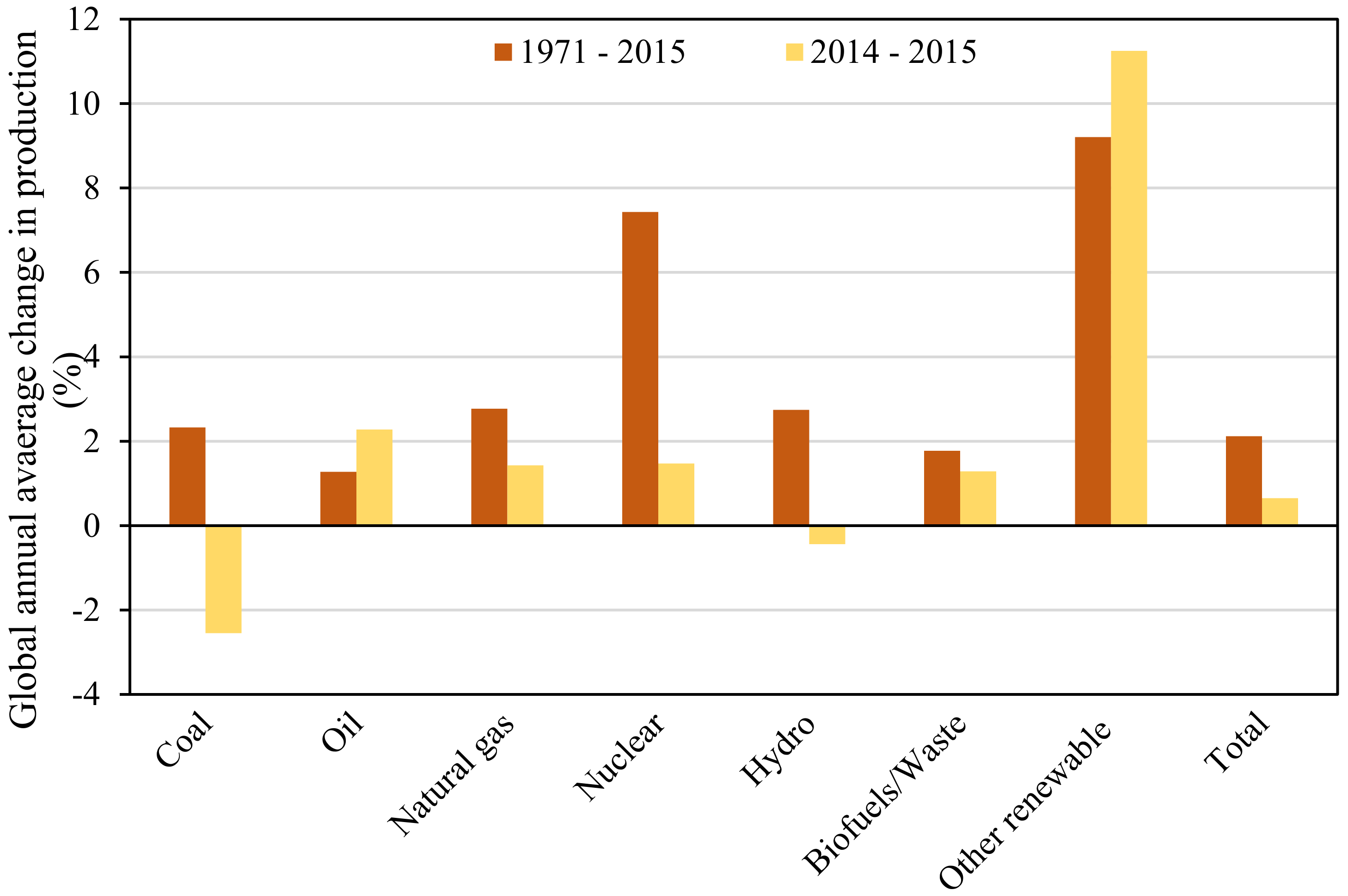
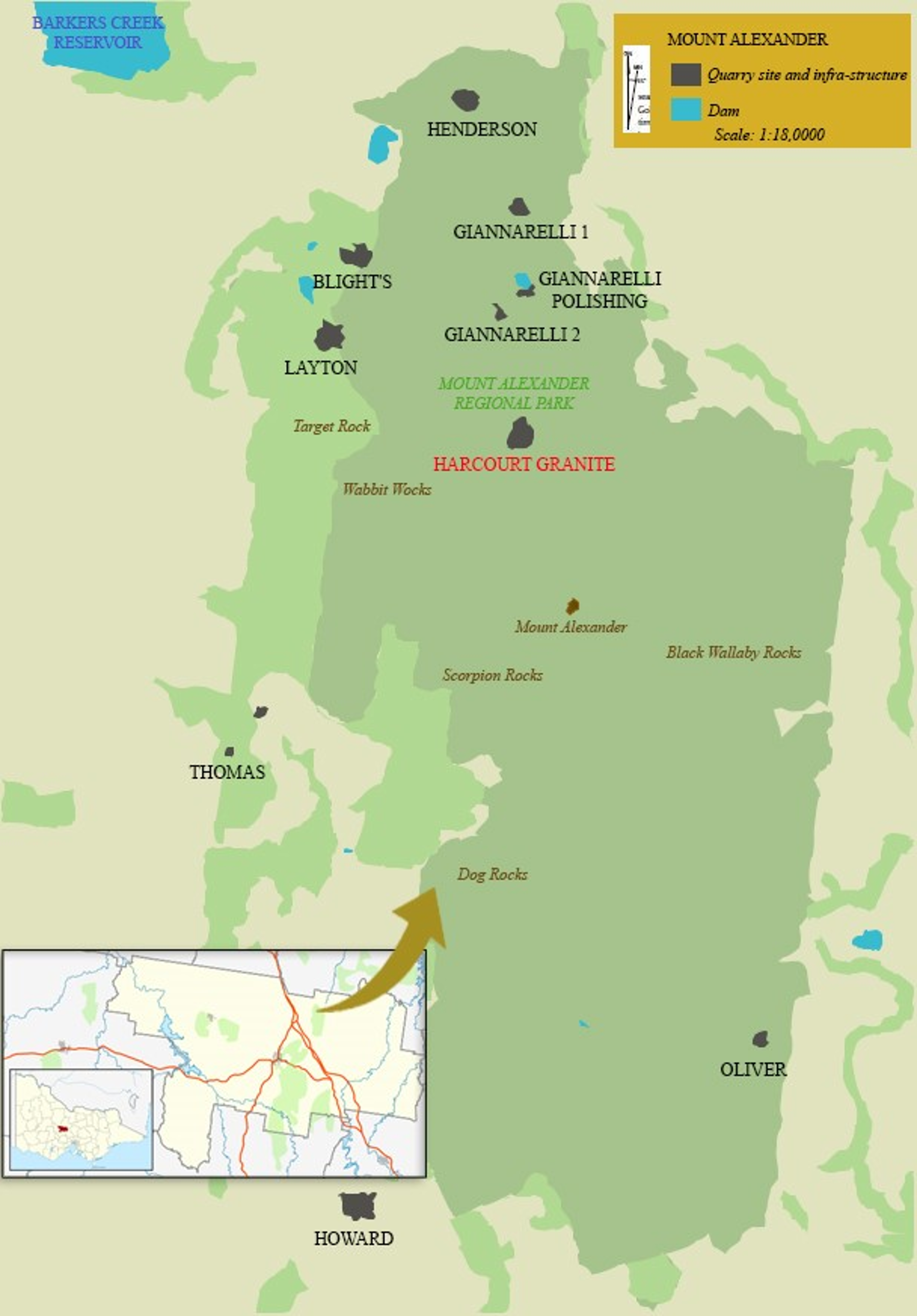
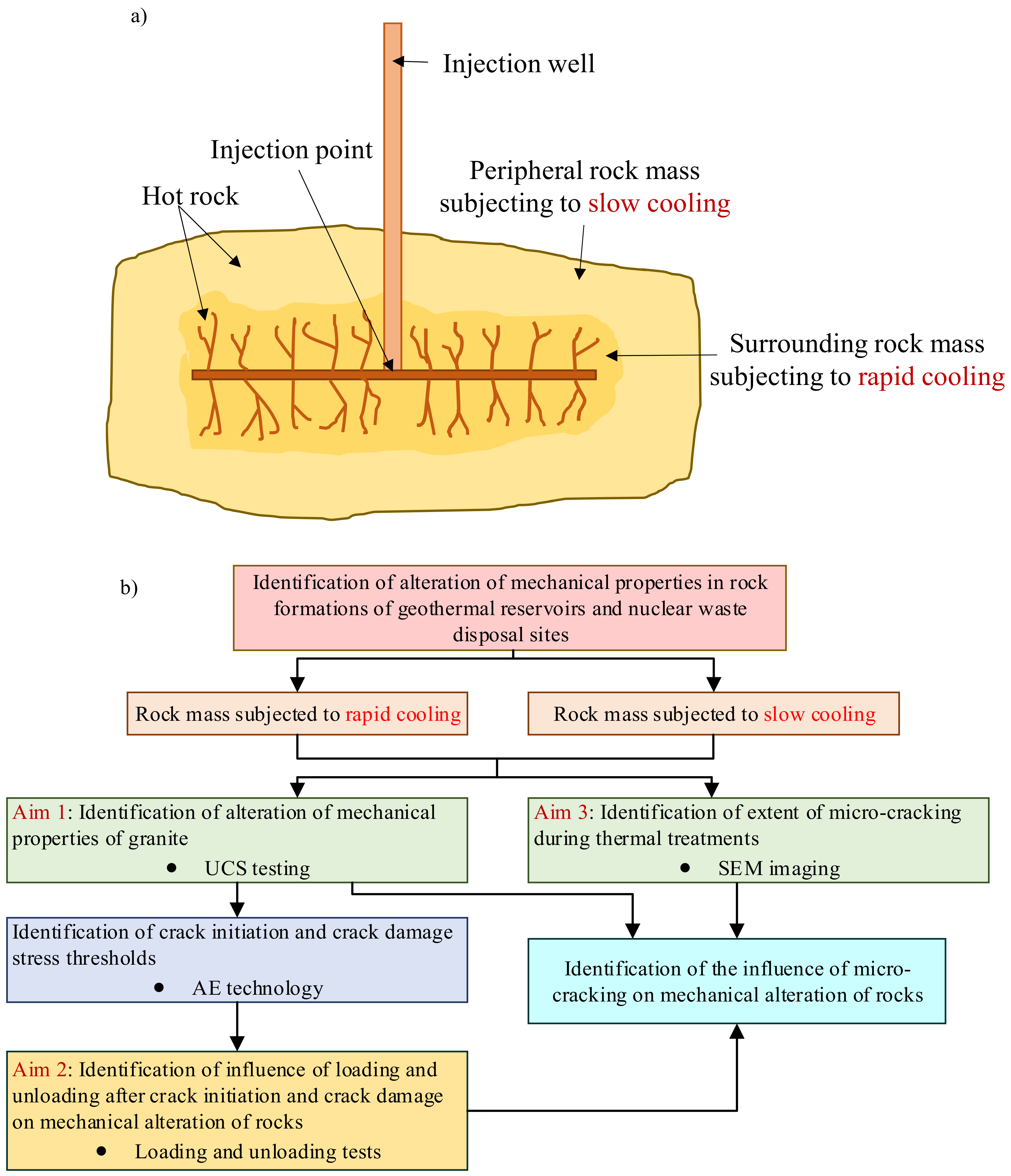
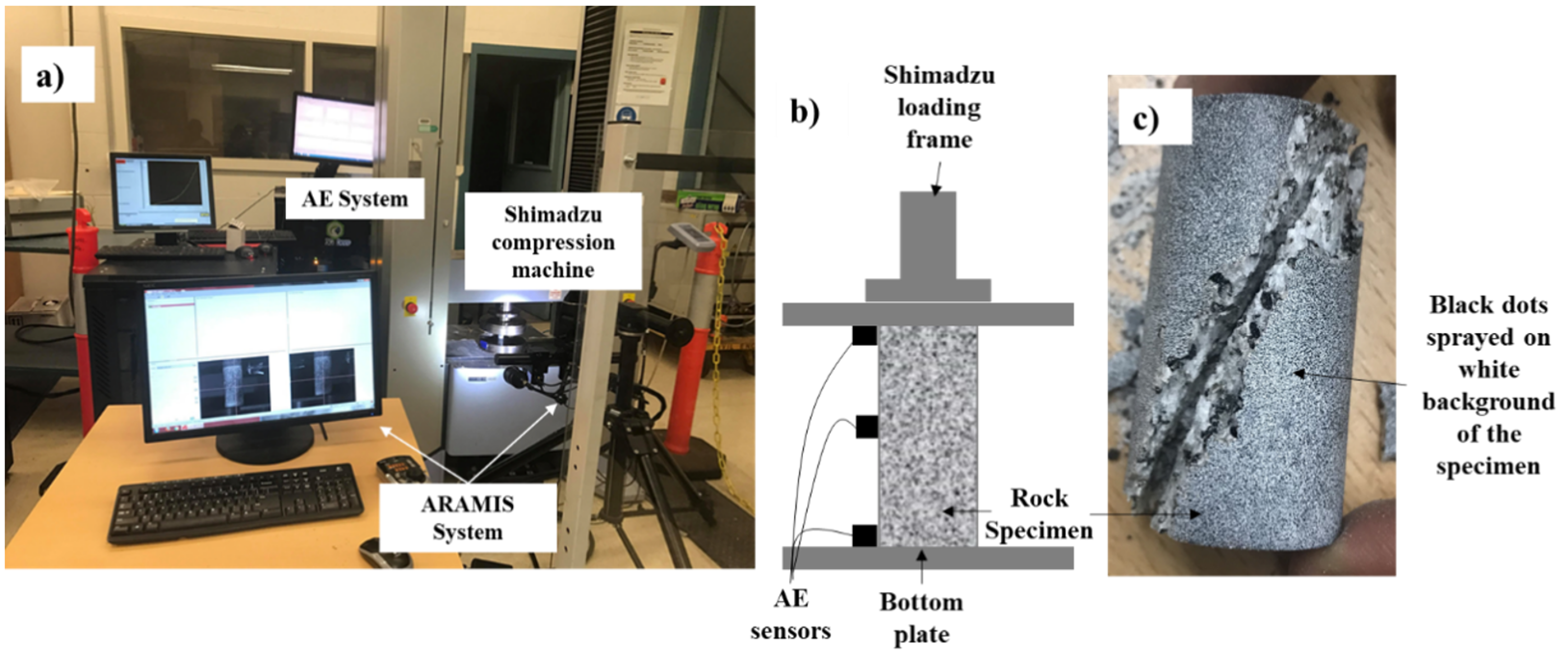
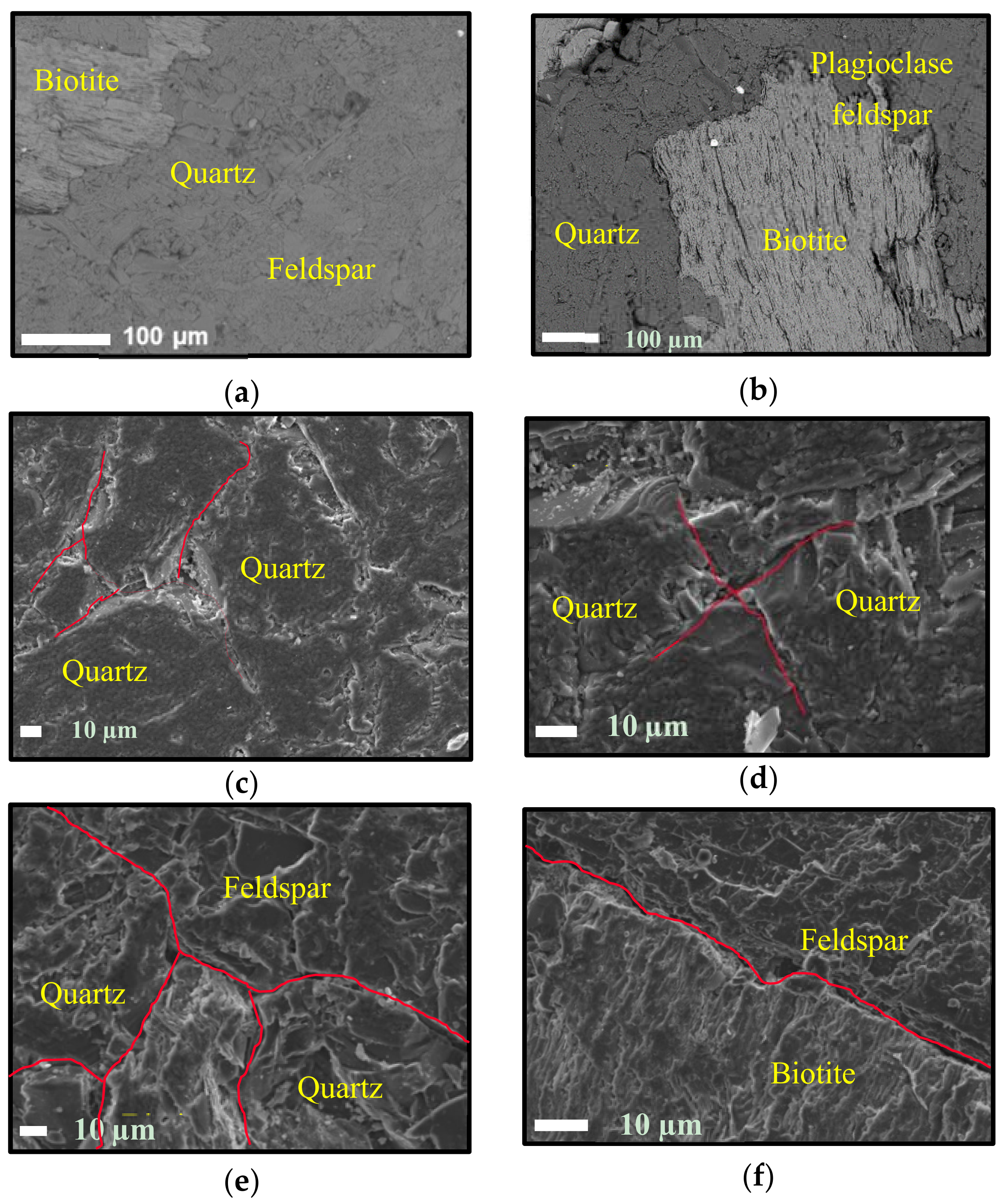


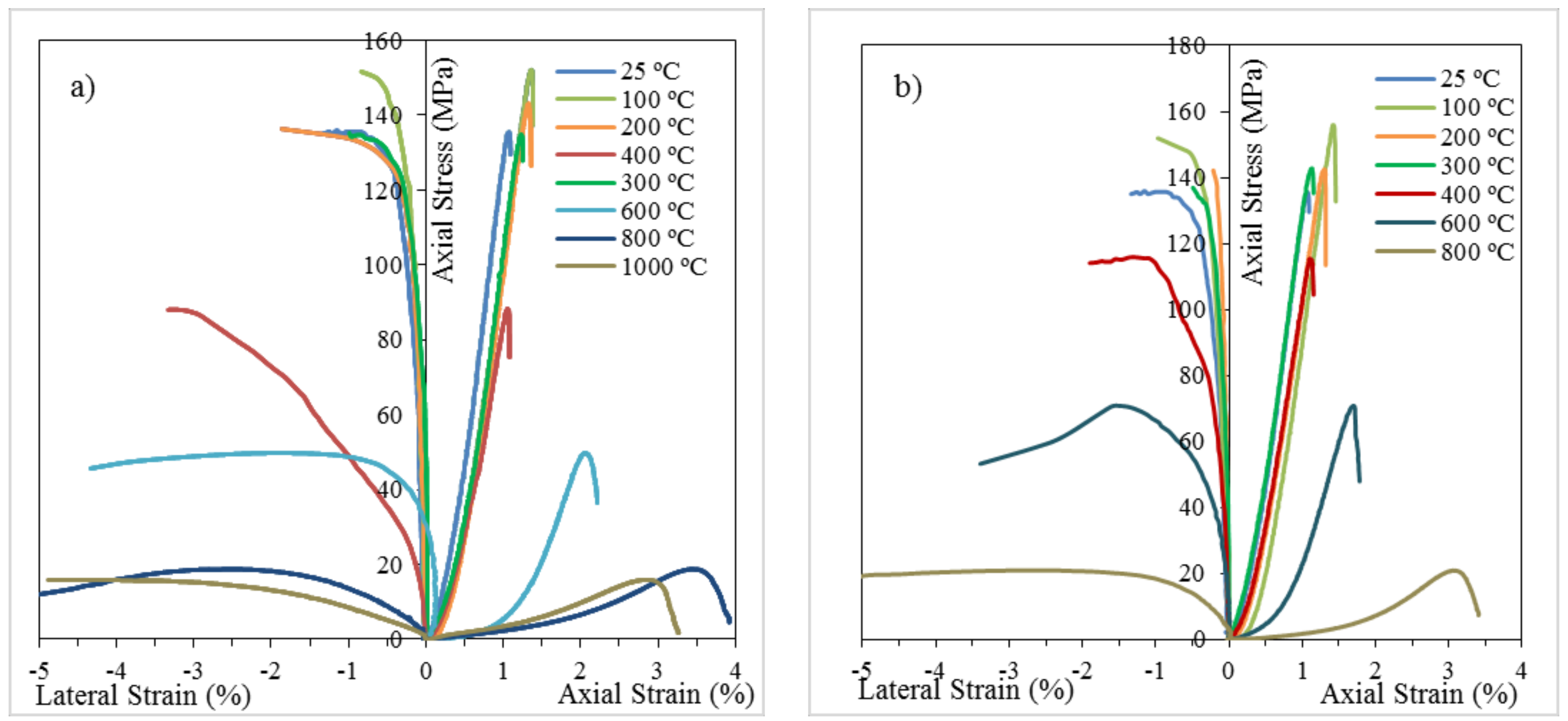
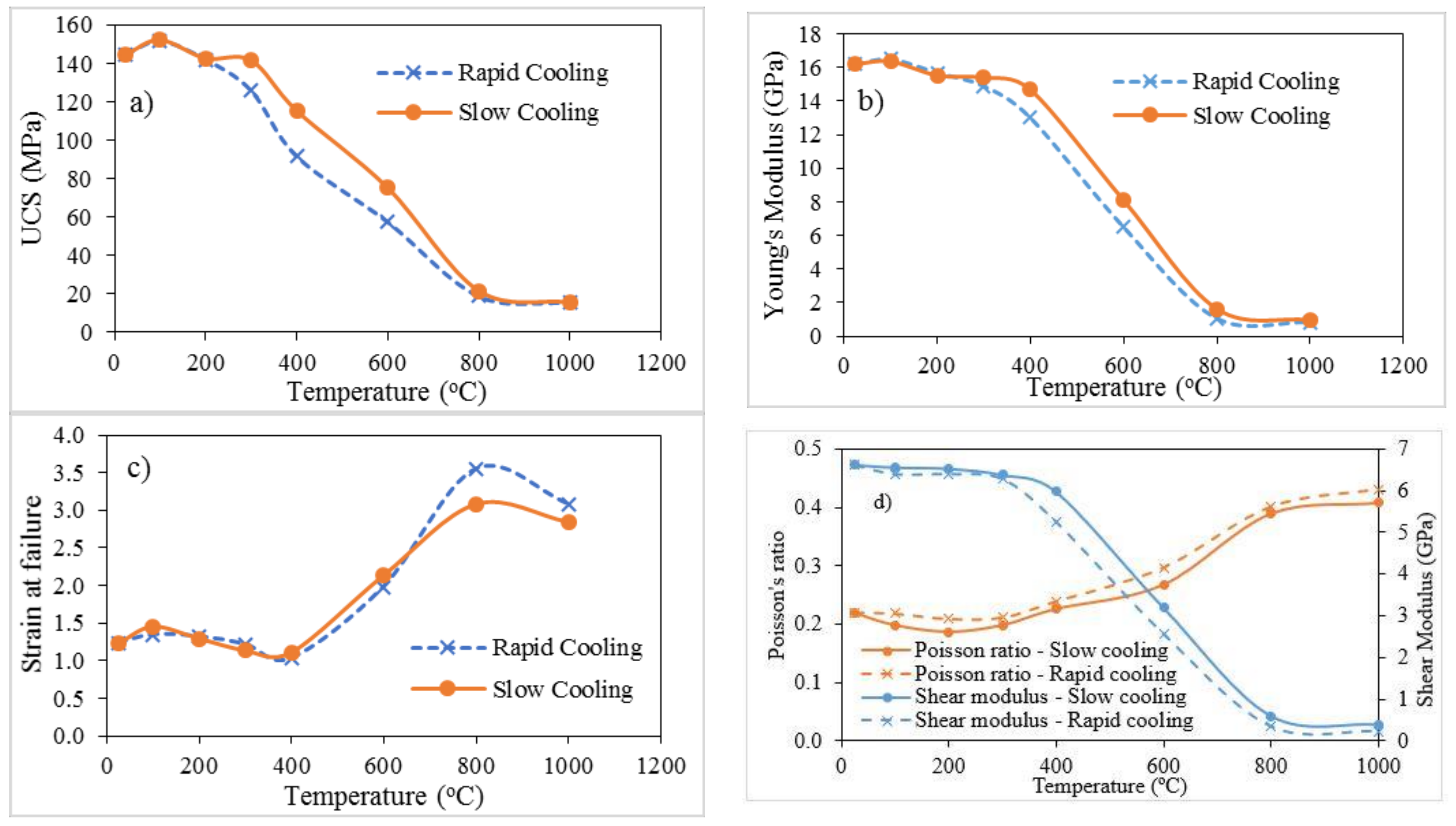
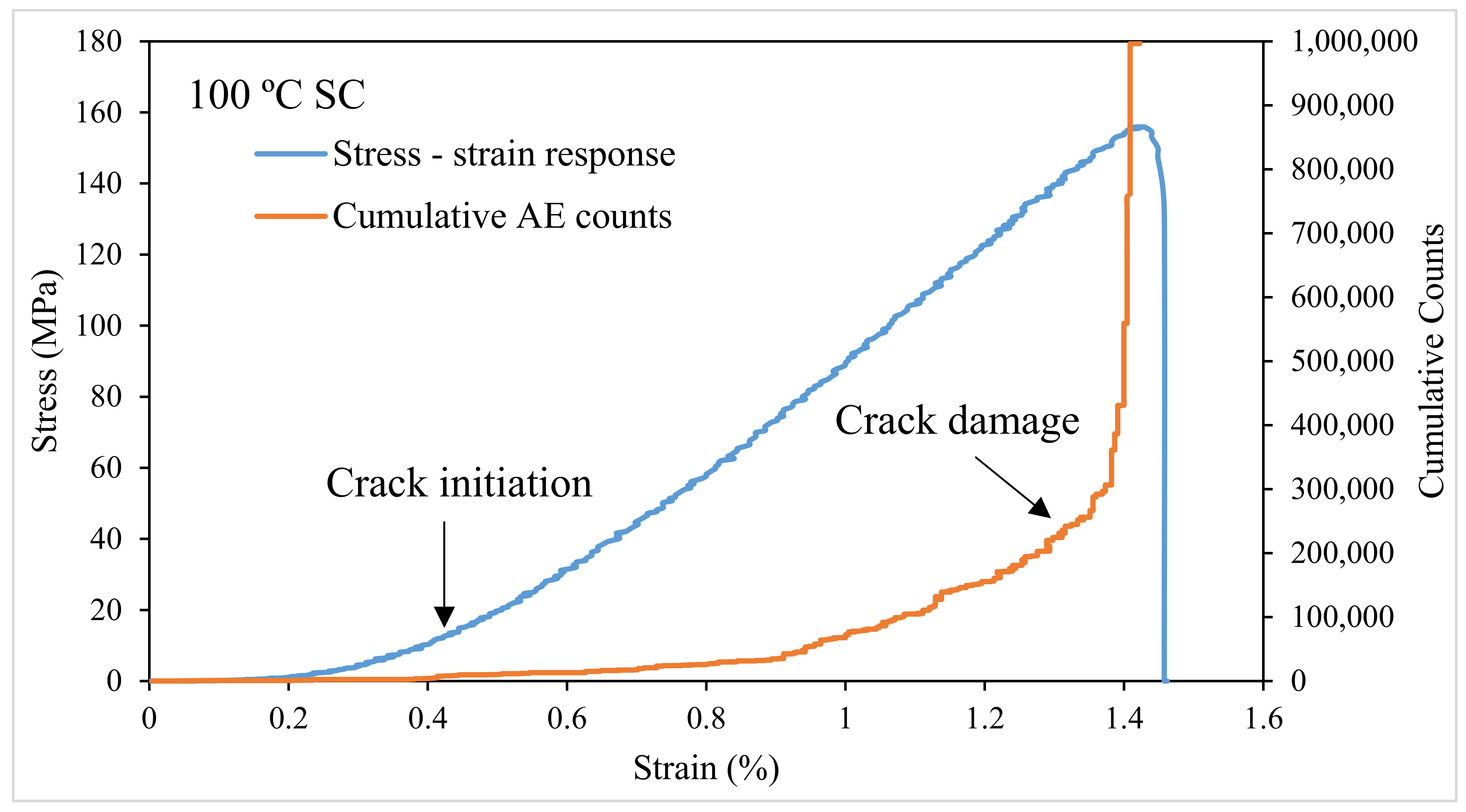

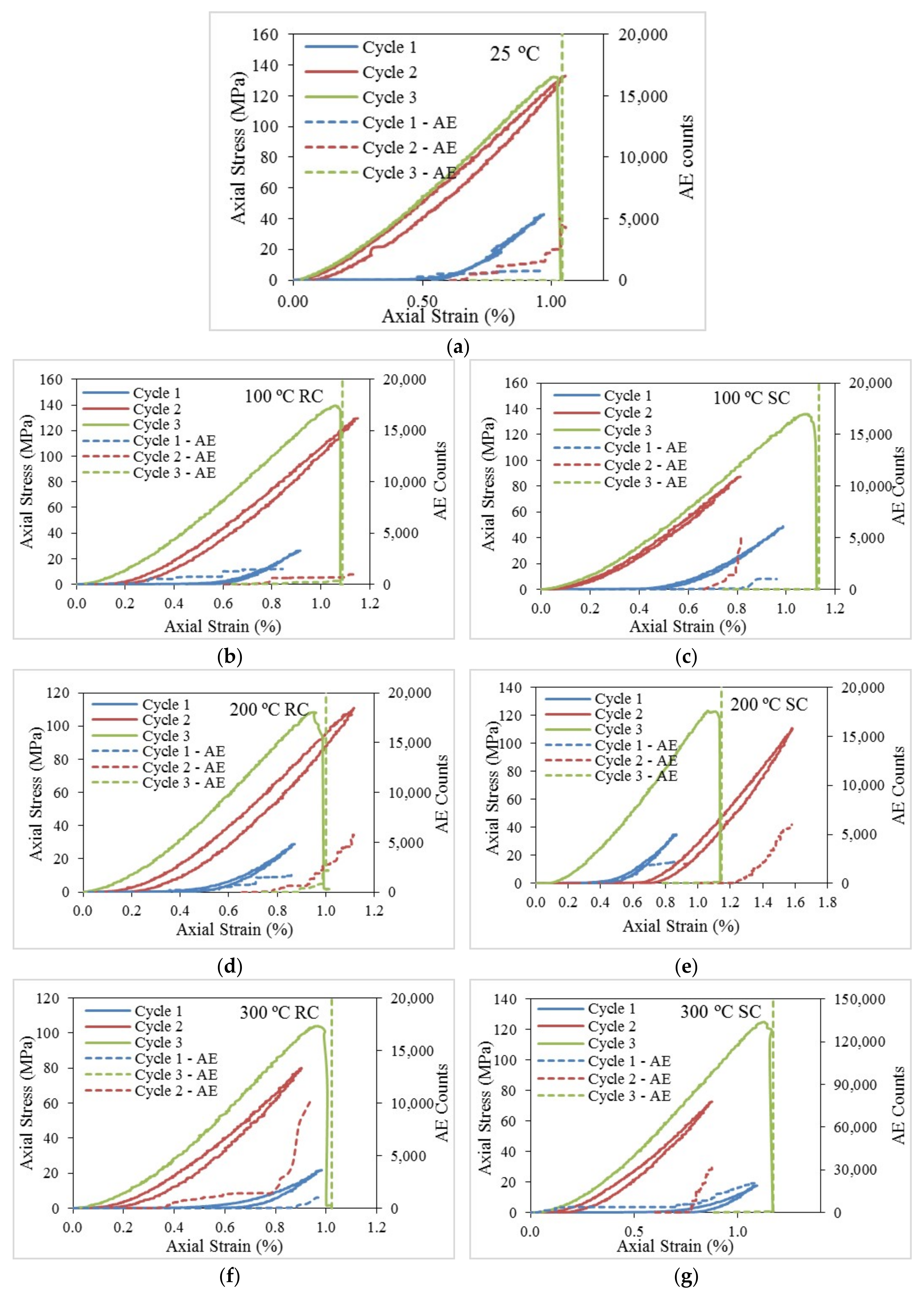
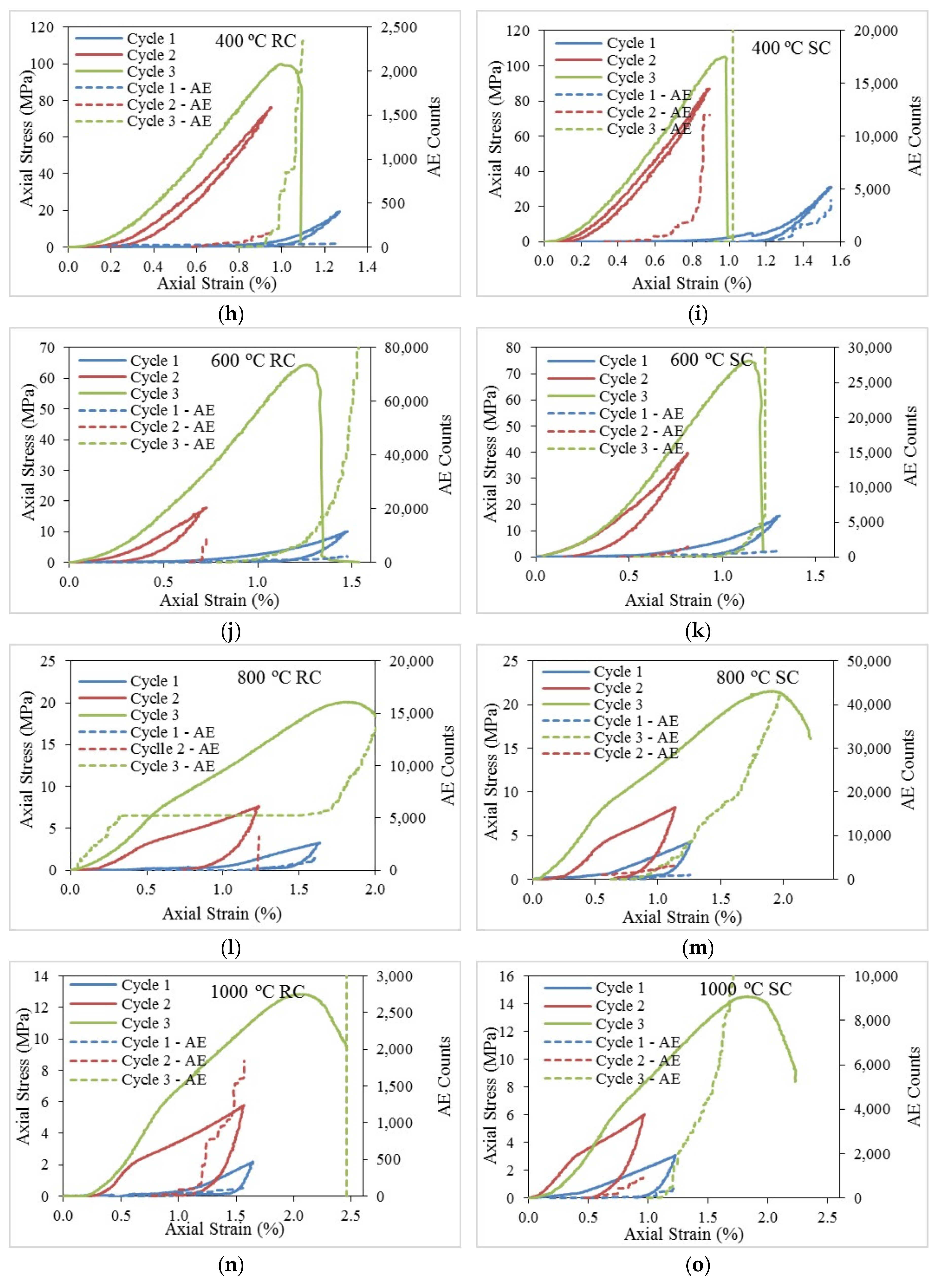
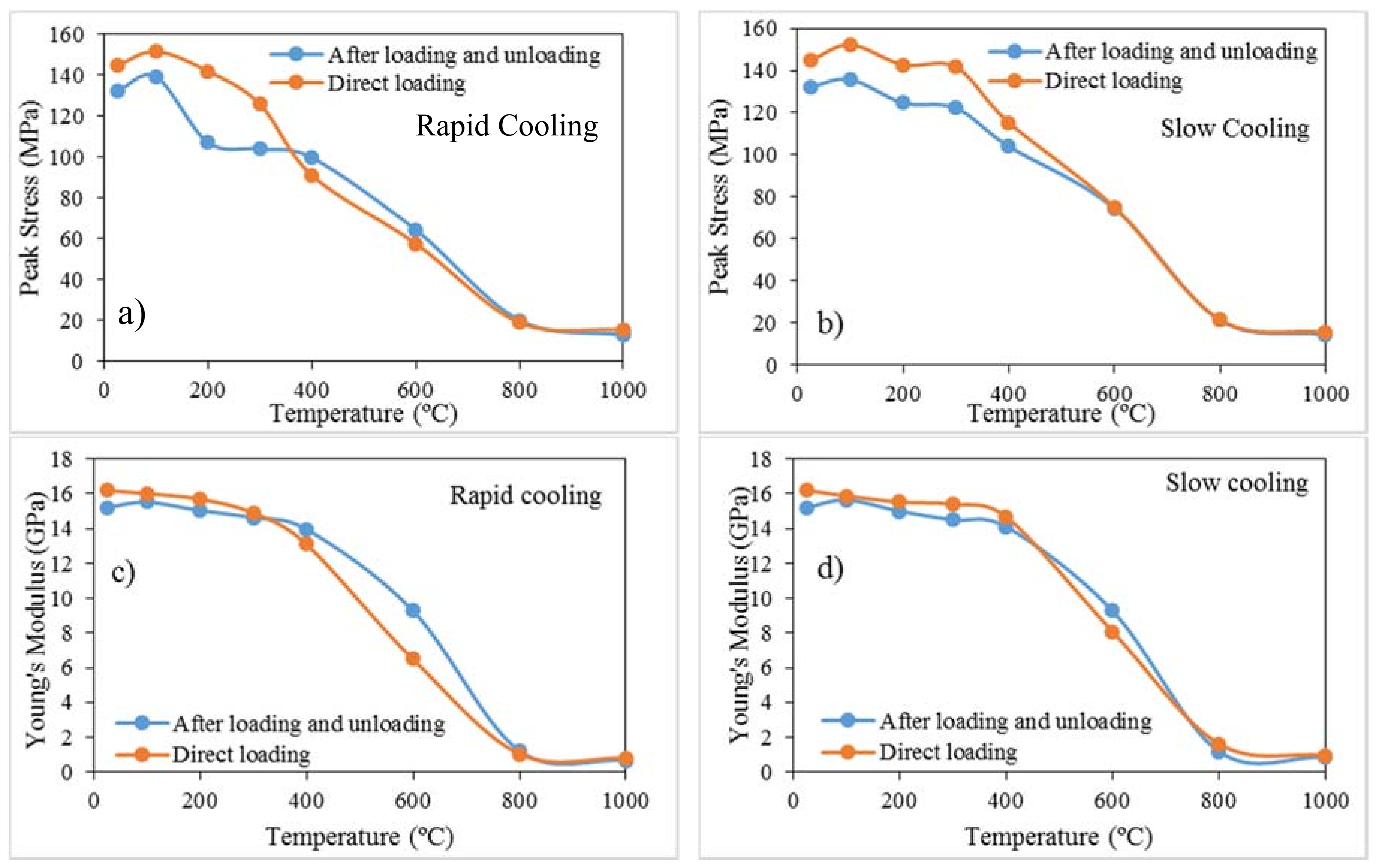
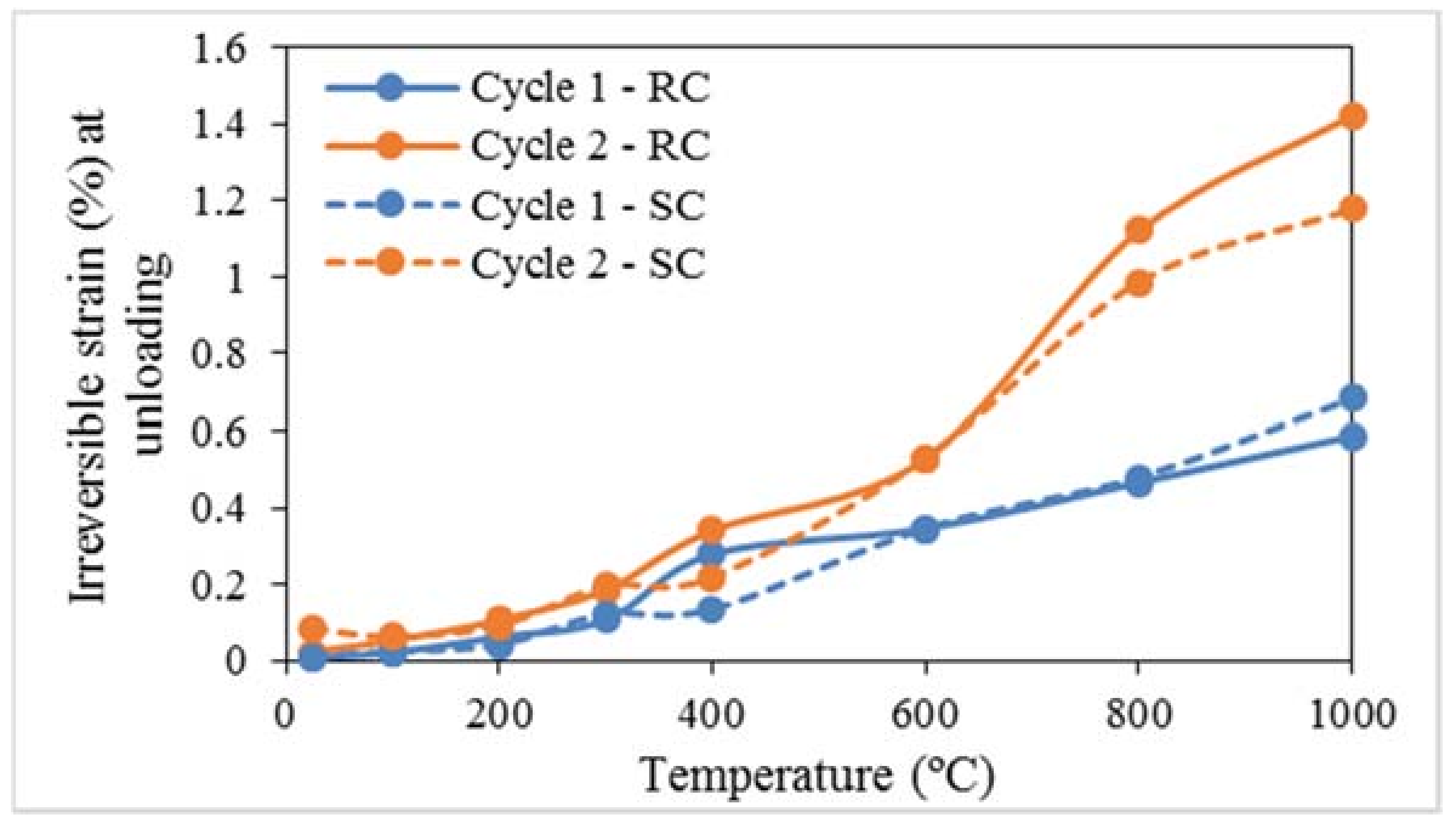
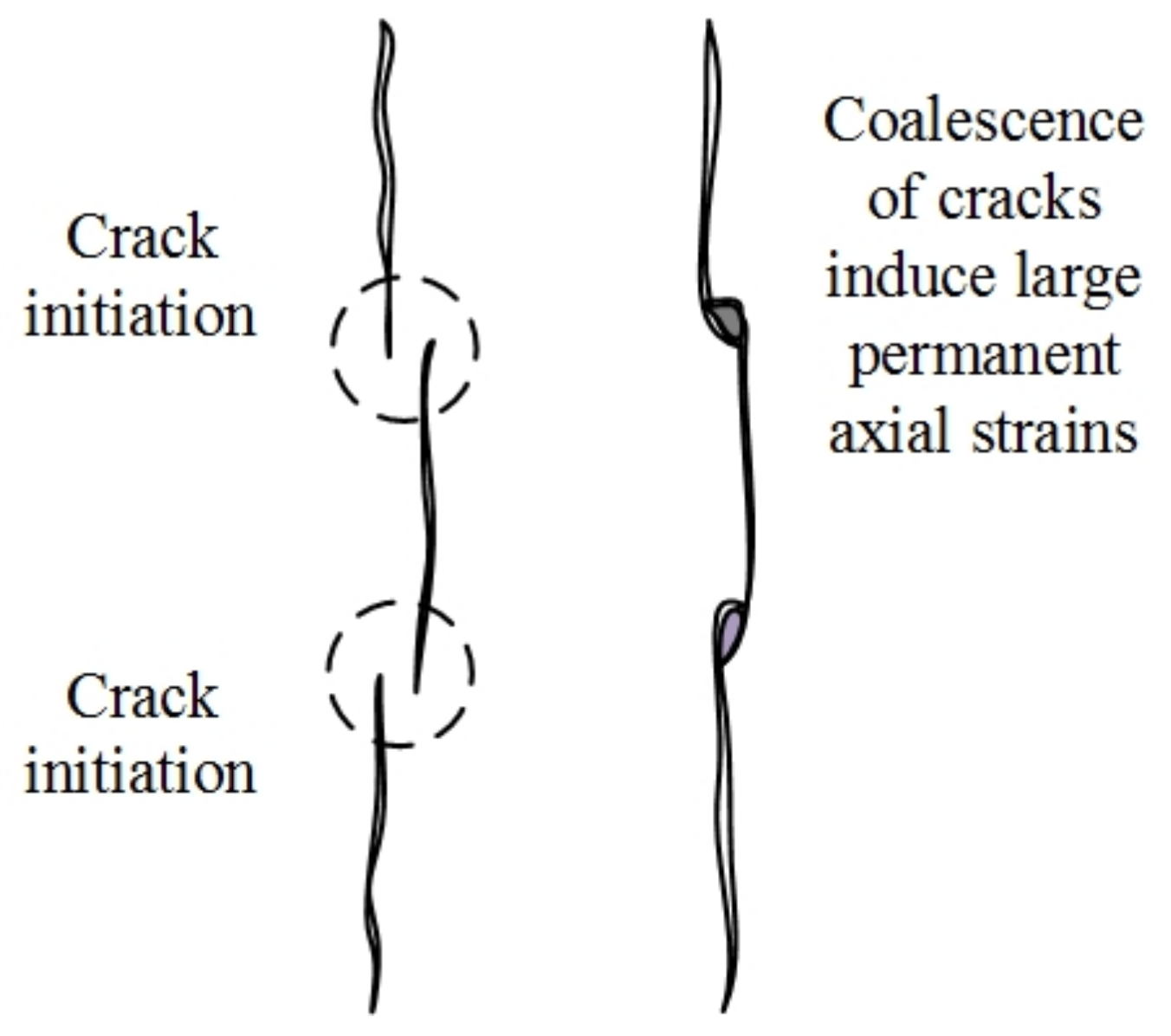
| Mineral Type | Composition (% by Mass) |
|---|---|
| Quartz | 46 |
| Plagioclase | 21 |
| Biotite | 17 |
| K-feldspar | 8 |
| Other minerals in minor percentages | 8 |
| Mineral Type | Feldspar | Quartz | Biotite |
|---|---|---|---|
| Coefficient of linear thermal expansion (10−6/K) (60–100 °C) | 4.5 | 9–14 | 12–16.5 |
| Specimen | UCS (MPa) | Average UCS (MPa) | Maximum Duration of the Test (Minutes) | Maximum Displacement at Failure (mm) | Young’s Modulus (GPa) | Average E | Average Poisson’s Ratio |
|---|---|---|---|---|---|---|---|
| 25 °C | 143.894 | 144.81 | 6.5 | 0.654 | 15.758 | 16.20 | 0.218 |
| 144.526 | 15.805 | ||||||
| 146.01 | 17.037 | ||||||
| 100 °C RC | 151.024 | 151.57 | 5.9 | 0.598 | 16.135 | 15.37 | 0.215 |
| 152.111 | 15.475 | ||||||
| 152.575 | 15.674 | ||||||
| 100 °C SC | 153.871 | 152.22 | 6.5 | 0.632 | 15.252 | 16.51 | 0.201 |
| 152.910 | 15.508 | ||||||
| 149.879 | 16.88 | ||||||
| 200 °C RC | 143.068 | 141.97 | 6.0 | 0.598 | 15.691 | 15.71 | 0.209 |
| 140.863 | 15.911 | ||||||
| 141.979 | 15.501 | ||||||
| 200 °C SC | 142.561 | 142.66 | 5.9 | 0.582 | 15.812 | 15.53 | 0.186 |
| 142.503 | 15.262 | ||||||
| 142.916 | 15.519 | ||||||
| 300 °C RC | 120.721 | 125.82 | 5.41 | 0.536 | 14.532 | 14.92 | 0.183 |
| 128.914 | 15.367 | ||||||
| 127.825 | 14.861 | ||||||
| 300 °C SC | 140.350 | 141.56 | 5.1 | 0.510 | 16.196 | 15.40 | 0.203 |
| 142.566 | 15.783 | ||||||
| 141.758 | 14.221 | ||||||
| 400 °C RC | 91.747 | 91.64 | 4.5 | 0.450 | 12.81 | 13.02 | 0.234 |
| 94.881 | 13.581 | ||||||
| 88.292 | 12.654 | ||||||
| 400 °C SC | 115.894 | 115.36 | 5.0 | 0.494 | 15.312 | 14.68 | 0.223 |
| 114.046 | 14.158 | ||||||
| 11.140 | 14.571 | ||||||
| 600 °C RC | 52.808 | 57.59 | 8.4 | 0.844 | 5.803 | 6.49 | 0.299 |
| 63.374 | 7.138 | ||||||
| 56.588 | 6.529 | ||||||
| 600 °C SC | 78.702 | 75.23 | 7.63 | 0.764 | 0.282 | 8.09 | 0.271 |
| 70.764 | 0.249 | ||||||
| 76.236 | 0.279 | ||||||
| 800 °C RC | 19.174 | 18.96 | 16.2 | 1.634 | 3.641 | 3.55 | 0.403 |
| 18.969 | 3.462 | ||||||
| 18.736 | 3.547 | ||||||
| 800 °C SC | 20.850 | 21.56 | 13.9 | 1.398 | 1.569 | 1.62 | 0.389 |
| 21.358 | 1.676 | ||||||
| 22.466 | 1.615 | ||||||
| 1000 °C RC | 15.913 | 15.35 | 14.8 | 1.482 | 0.791 | 0.802 | 0.430 |
| 14.887 | 0.751 | ||||||
| 15.251 | 0.864 | ||||||
| 1000 °C SC | 15.915 | 15.72 | 13.9 | 1.384 | 0.928 | 0.948 | 0.411 |
| 15.233 | 0.964 | ||||||
| 16.004 | 0.952 |
| Specimen | Average Crack Initiation Stress (MPa) | Average Crack Damage Stress (MPa) | Crack Initiation Threshold | Crack Damage Threshold |
|---|---|---|---|---|
| 25 °C | 43.01 | 133.47 | 0.298 | 0.922 |
| 100 °C RC | 10.43 | 129.49 | 0.174 | 0.857 |
| 100 °C SC | 34.91 | 110.68 | 0.224 | 0.841 |
| 200 °C RC | 29.59 | 111.52 | 0.206 | 0.788 |
| 200 °C SC | 48.78 | 87.34 | 0.343 | 0.792 |
| 300 °C RC | 21.68 | 80.33 | 0.186 | 0.688 |
| 300 °C SC | 31.26 | 86.91 | 0.223 | 0.698 |
| 400 °C RC | 19.46 | 43.66 | 0.205 | 0.494 |
| 400 °C SC | 17.66 | 72.94 | 0.153 | 0.632 |
| 600 °C RC | 10.04 | 18.34 | 0.201 | 0.361 |
| 600 °C SC | 15.67 | 40.35 | 0.211 | 0.565 |
| 800 °C RC | 3.32 | 7.91 | 0.172 | 0.412 |
| 800 °C SC | 4.28 | 8.45 | 0.205 | 0.405 |
| 1000 °C RC | 2.26 | 5.96 | 0.152 | 0.400 |
| 1000 °C SC | 3.05 | 6.08 | 0.191 | 0.380 |
© 2018 by the authors. Licensee MDPI, Basel, Switzerland. This article is an open access article distributed under the terms and conditions of the Creative Commons Attribution (CC BY) license (http://creativecommons.org/licenses/by/4.0/).
Share and Cite
Isaka, B.L.A.; Gamage, R.P.; Rathnaweera, T.D.; Perera, M.S.A.; Chandrasekharam, D.; Kumari, W.G.P. An Influence of Thermally-Induced Micro-Cracking under Cooling Treatments: Mechanical Characteristics of Australian Granite. Energies 2018, 11, 1338. https://doi.org/10.3390/en11061338
Isaka BLA, Gamage RP, Rathnaweera TD, Perera MSA, Chandrasekharam D, Kumari WGP. An Influence of Thermally-Induced Micro-Cracking under Cooling Treatments: Mechanical Characteristics of Australian Granite. Energies. 2018; 11(6):1338. https://doi.org/10.3390/en11061338
Chicago/Turabian StyleIsaka, Badulla Liyanage Avanthi, Ranjith Pathegama Gamage, Tharaka Dilanka Rathnaweera, Mandadige Samintha Anne Perera, Dornadula Chandrasekharam, and Wanniarachchige Gnamani Pabasara Kumari. 2018. "An Influence of Thermally-Induced Micro-Cracking under Cooling Treatments: Mechanical Characteristics of Australian Granite" Energies 11, no. 6: 1338. https://doi.org/10.3390/en11061338
APA StyleIsaka, B. L. A., Gamage, R. P., Rathnaweera, T. D., Perera, M. S. A., Chandrasekharam, D., & Kumari, W. G. P. (2018). An Influence of Thermally-Induced Micro-Cracking under Cooling Treatments: Mechanical Characteristics of Australian Granite. Energies, 11(6), 1338. https://doi.org/10.3390/en11061338









